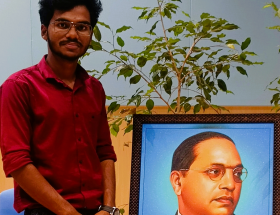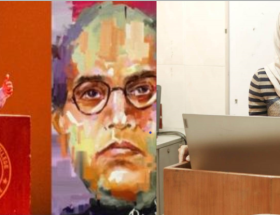Pranav Jeevan P
The Supreme Court of the United States (SCOTUS) has deemed Affirmative Action AA) programs in Harvard and University of North Carolina which regard race as a factor for admissions to be unconstitutional. Affirmative action is a policy initiative in which a person’s nationality, sex, religion, race, and caste are considered by an organization to extend employment or education opportunities in areas in which such groups are underrepresented. Historically and internationally, support for affirmative action has sought to achieve goals such as bridging inequalities in employment and pay, increasing access to education, promoting diversity, and redressing wrongs, harms, or hindrances. The AA programs in US is not as strong or procedurally precise as the Reservation Policy in India.
This decision to abolish AA was expected from the conservative majority court which had recently overturned Roe vs Wade and deemed abortion to be unconstitutional. Many of the arguments which the court used to oppose AA is what we hear from savarnas who argue against reservation, such as:
- AA violates Right to Equality (14th Amendment) of the US constitution
- AA is the cause of discrimination that racial minorities face due to stereotyping
- AA was supposed to be a temporary policy and should be scrapped now
- Discarding the advantages of having diversity in educational institutions and the educational benefits it provides
- Minority students who benefit from AA cannot perform in universities compared to others, so they are better off in low-tier colleges
- AA can increase racism towards minorities
- Discarding how race affects other socio-economic factors and quality of life
The organization Students For Fair Admissions (SFFA) argued that admissions to Asian Americans are suffering due to AA for African-American and Hispanic minorities even though Harvard’s data shows that 19% of their students are Asian Americans (who compose 7.3% of US population) compared to 12% African-Americans (who compose 12.1% of US population) and 12% Hispanics (who compose 19% of US population). The data clearly shows that Asian-Americans are already over-represented compared to their share in population, so are the White-Americans. Harvard’s application files also show that race-conscious holistic admissions allow Harvard to value the diversity of Asian American applicants’ experiences. Data shows that admission rates of Asian Americans at institutions with race-conscious admission policies have been steadily increasing. By contrast, Asian American enrollment declined at elite universities that were prohibited by state from considering race during admissions.
It is very ironic that the concurring judges wrote pages and pages glorifying Equality (14th Amendment) while ignoring the impact of historical effects of slavery and racism today. The concurring judges also furiously attacked the dissenting opinion by Justice Jackson.
US universities have a long history of white supremacy, exclusion of people of color from faculty and students, glorification of slavery, resistance to integration, harassment, humiliation, and isolation of minority students. The student bodies remain predominantly white even today. Professors of these universities have openly promoted racist eugenics, and theories rooted on racial hierarchy. These institutions have been forced to change through societal and legal transformations. Acknowledging the reality that race has always mattered and continues to matter, these universities have established institutional goals of diversity and inclusion. They use AA policies which use race as criteria with a goal of admitting underrepresented racial minorities to pursue the well-documented benefits of racial integration in education. Harvard had tried to implement some proposals by SFFA such as increasing recruitment efforts and financial-aid for low-income students, but these methods alone proved insufficient to achieve the diversity goals.
Justice Sonia Sotomayor, the first Hispanic woman judge in SCOTUS, in her dissenting verdict states that Equality (14th Amendment) enshrines racial equality and its guarantee can only be enforced through race-conscious means in society that is racist. A superficial rule of colorblindness as a constitutional principle subverts the constitutional guarantee of equal protection by further entrenching racial inequality in education. The major reason for passage of 14th Amendment was to provide equality to the recently emancipated black people who were bound in slavery for many generations. It enabled the US government to enact several race-conscious laws to fulfill the Amendment’s promise of equality and provide protection, education, and other benefits for African-Americans. During the era of slavery, African-Americans were not allowed to be educated; during the segregation era, they were excluded from schools for white children, perpetuating a caste system wherein black children received inferior educational opportunities solely because of their race, denoting their inferior status in society. The desegregation of schools and colleges was meant to ensure racial equality of opportunity, and not an imposition of a formulistic rule of color-blindness. But, passively eliminating race classifications was not enough to avoid segregation. Affirmative steps are constitutionally necessary where mere formal neutrality cannot achieve racial equality. Active affirmative steps were need to ensure integration even after laws were passed abolishing segregation of schools. Even today, most of the US schools are racially homogenous with racially segregated minority schools increasing. Underrepresented minority students are more likely to live in poverty and attend schools with limited resources, less qualified teachers, less challenging curricula, and fewer extracurricular activities. There is achievement gap among racial lines even after controlling for income differences.
Justice Ketanji Brown Jackson, the first black woman judge in SCOTUS, in her dissent says that claim of disadvantage to white applicants from race-conscious admissions fails to acknowledge the well documented intergenerational transmission of inequality in US. US has a history of passing laws that favor White Americans and which ensure that black people always live as second-class citizens. For example, due to Govt. policies, less than 1% of home loans went to African Americans between 1930s to 1960s. By always excluding black people, government policies affirmatively acted to give preference to White Americans for decades and those preferences got carried forward and are reinforced today. The mean wealth of black families in 2019 was $24,000 compared to $188,000 for white families. Because of lower family income, black students who do graduate find themselves in twice the student debt compared to white students.
Education plays a central role in ending racial inequality. Racial integration improves cross-racial understanding, break down racial stereotypes…through exposure to diverse people, cultures, ideas, and viewpoints. Universities should pursue the benefits of racial diversity and ensure that diffusion of knowledge and opportunity is available to students of all races. Equal Protection Clause of the 14th Amendment authorizes a limited use of race in college admissions (through AA) due to the educational benefits from a diverse student body. AA tries to equalize educational opportunity in a society structured by racial segregation and guarantee students of all races equal protection of the laws. Race-conscious college admissions are critical for providing equitable and effective public services. Increasing the number of students from underrepresented backgrounds who join medical professionals improves healthcare access and health outcomes in medically underserved communities. Greater diversity within the teacher workforce improves student academic achievement in primary public schools. A diverse pool of college graduates also ensures a diverse legal profession, which demonstrates that the justice system serves the public in a fair and inclusive manner. It also improves research by reducing bias and increasing group collaboration.
A college degree from an elite institution carries with it the benefit of powerful networks and the opportunity for socioeconomic mobility giving entry ticket to top jobs where important decisions are made. A less diverse pipeline to these top jobs accumulates wealth and power unequally across race lines, exacerbating racial disparities in a society that already dispenses prestige and privilege based on race and reserves positions of influence, affluence, and prestige for a predominantly white pool of college applicants. Passive race neutrality was inadequate to achieve the constitutional guarantee of racial equality in a nation where effects of segregation persist. In a society where race continues to matter, there is no constitutional requirement that institutions attempting to remedy their legacies of racial exclusion must operate with a blindfold. Ensuring a diverse student body in higher education helps everyone, not just those who, due to their race, have directly inherited distinct disadvantages with respect to their health, wealth, and wellbeing. Students of every race will come to have a greater appreciation and understanding of civic virtue, democratic values, and commitment to equality which is essential for growth and prosperity of a democratic nation. Society does better, generation after generation, when we extend educational opportunities to people who historically haven’t gotten them.
Students of color, especially black students are disproportionately disciplined or suspended, interrupting their academic progress, and increasing their risk of involvement with criminal justice system. They do not have social or cultural capital, or parents who are graduates to guide them through college admission procedures. There structural barriers result in fewer students from racial minorities enrolling in colleges compared to whites. Talent lives everywhere, but opportunity does not, and these talented students with great potential never had the opportunity to attain the traditional indicator of merit that provides a competitive edge in admission processes. A myopic focus on academic ratings such as scores on a standardized test does not lead to a diverse student body. Considering race as a factor in admission enable the university to acknowledge the historical privileges and disadvantages that each applicant was born with.
Studies have time and again disproved the mismatch hypothesis that says that minority students who come through AA perform poorer and suffer from stereotypes as they cannot cope with the advanced workload. Studies have shown that students suffer from stigma not because of AA but because of the racial stereotypes attached historically to different groups.
Superficial colorblindness in a society that systematically segregates opportunity will cause a sharp decline in the rates at which underrepresented minority students enroll in colleges and universities, undoing the slow yet significant progress already achieved through AA. After the state of California prohibited race-conscious college admissions, black students in UC Berkeley dropped from 6.32% to 3.37% and Latino representation dropped from 15.57% to 7.28%.
The current majority verdict assumes that indifference to race is the only constitutionally permissible means to achieve racial equality in college admissions and is grounded on the illusion that racial inequality was a problem of the past. Ignoring race will not equalize a society that is racially unequal. Equality requires acknowledgement of inequality. Equality is an ongoing project in a society where racial inequality persists. A temporal requirement that rests on the fantasy that racial inequality will end at a predictable hour is illogical and unworkable. Instead of setting a time limit for ending AA, AA will become redundant when the student composition inside universities reflects the composition of the society and when indicators of quality of life stops remaining racially unequal.
The SCOTUS had previously (1975) not accepted a race-blind rule and deemed it okay for border patrol to rely on racial features of Mexicans for inspection of potential suspects. The result of current verdict is that a person’s skin color may play a role in assessing individualized suspicion, but it cannot play a role in accessing that person’s individualized contributions to a diverse learning environment. The court also exempted military academies from the current ruling and accepted race-based admissions permissible there basically showing that it is okay for using AA in recruiting minority candidates for military duty but not for positions of influence and power gained through education from elite educational institutions thereby enabling racial/ethnic minorities to serve as cannon fodder for white military leaders.
Deeming race irrelevant in law does not make it so in real life. Majority opinion of SCOTUS believes that preventing consideration of race will end racism. Ignoring race just makes it matter more. Today’s racial inequality exists because freedom was denied far longer than it was ever afforded to racial minorities. This ahistorical interpretation, and the broader pushback against the diversity that it represents, leaves anyone who is not a cisgendered white man with fewer opportunities than before.
One thing to notice here is that the US universities argued in favor of AA while our premier universities such as IITs/IIMs still shy away from implementing constitutionally mandated reservations in student and faculty admissions. Although SCOTUS has stripped out almost all uses of race in college admissions, US universities can and should continue to use all available tools to meet society’s needs for diversity in education.
Today’s gaps exist because that freedom was denied far longer than it was ever afforded. ~ Justice Ketanji Brown Jackson
~~~
Pranav Jeevan P is currently a PhD candidate in Artificial Intelligence at IIT Bombay. He has earlier studied quantum computing in IIT Madras and Robotics at IIT Kanpur.










